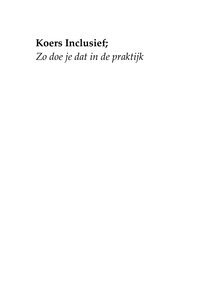Hoofdstuk 4 in Schakels in de buurt. De wijk Randenbroek ligt in het zuidoosten van Amersfoort en grenst direct aan de binnenstad. Een eerste deel van de wijk stamt uit de jaren twintig en dertig van de vorige eeuw, maar de grootste uitbreiding vond vlak na de tweede wereldoorlog plaats, waarmee het gebied deel uitmaakt van een gordel van naoorlogse uitbreidingen rondom de binnenstad van Amersfoort. Er werden veel nieuwe woningen gebouwd, zowel flatgebouwen als eengezinswoningen. De woonwijk Schuilenburg stamt uit de tweede helft van de jaren zestig en sluit iets oostelijker op Randenbroek aan. Schuilenburg is meer eenvormig gebouwd, hoewel er wel sprake is van een duidelijk verschil tussen het noorden en het zuiden van Schuilenburg. Schuilenburg-Noord heeft langs de randen van de buurt veel goedkope portiek- en galerijflats uit de jaren vijftig en zestig van de vorige eeuw; in Schuilenburg-Zuid staan duurdere koopwoningen en appartementen
DOCUMENT

LINK
Motor activation is rarely integrated into the support of people with profound intellectual and multiple disabilities (PIMD), which might be the result of the limited evidence-based knowledge in this field. Practitioners have recently been developing several motor initiatives for people with PIMD, but it remains unclear about what core elements the motor initiatives actually consist of and towhat level of quality it is implemented in practice. This study aims to offer an overview and analysis of the content and quality of motor initiatives actually in use for people with PIMD. Motor initiatives were explored by asking practitioners to complete an online inventory form. Documents, expert knowledge, and observations were used to collect data about the characteristics of themotor initiatives. The quality of the motor initiatives which met our eligibility criteria, was analyzed on the basis of the level of evidencefor their effectiveness. The inventory yielded 118 motor initiatives of which 17 met the eligibility criteria. We identified four motor initiatives reflecting an approach to motorically activate people with PIMD within various activities, three including powerassisted exercises, three with aquatic exercises, two frameworks which integrated motor activities into their daily programs, two methods which included small-scale activities, two rhythmic movement therapies, and one program including gross motor activities. We found limited indications for descriptive evidence from 17 initiatives, limited or no indications for theoretical evidence from 12 and five initiatives respectively, and none of the initiatives provided a causal level of evidence for effectiveness. A wide variety of motor initiatives is used in current practice to activate persons with PIMD, although their effectiveness is actually unproven.Science and practice should cooperate to develop an evidence-based understanding to ensure more evidence-based support for themotor activation of people with PIMD in the future.
DOCUMENT
In de laatste jaren is er in Nederland toenemende aandacht voor de condities waarin leerlingen les krijgen. Randvoorwaarden zoals temperatuur, akoestiek, luchtkwaliteit, lichtkwaliteit en beschikbare ruimte vormen met elkaar de basisomstandigheden waarin leerlingen en leerkrachten functioneren. Er is betrekkelijk weinig aandacht voor de invloed die akoestiek en luisteromstandigheden hebben op het leerproces van de leerlingen, terwijl het evident is dat deze enkele van de belangrijkste randvoorwaarden vormen voor het kunnen volgen van het onderwijs in de klas. De verwerving van taal èn het leerproces op school vinden immers voor een groot deel plaats via luisteren en talige interactie. Om meer inzicht te krijgen in de invloed die luisteromstandigheden in de klas hebben op leerlingen, is een onderzoek uitgevoerd met klassenversterkingsapparatuur, ook wel Soundfield apparatuur genaamd. Het onderzoek vond plaats op vijf Friese basisscholen in tien verschillende klassen en duurde vier weken. De Soundfield apparatuur bestaat uit een leerkrachtmicrofoon met zender en een luidsprekersysteem met versterker en ontvanger. Met de apparatuur ontstaat er een gelijkmatig „geluidsveld‟ in de klas, waardoor de leerkracht overal even goed hoorbaar is. Er werd gebruik gemaakt van apparatuur met infrarood technologie (Redcat: Infrared Classroom Amplification Technology van Lightspeed Technology).
DOCUMENT

Vanuit het ‘Landelijk Platform Ernstig Meervoudig Gehandicapten’ bestond de wens om een inventarisatie te maken van het aantal personen met (zeer) ernstige verstandelijke en meervoudige beperkingen (EMB) in Nederland en hun persoonskenmerken, omgevingsfactoren en bekostigingsvariabelen. Deze inventarisatie is uitgevoerd vanuit het ‘Research Centre on Profound and Multiple Disabilities’ van de Rijksuniversiteit Groningen.
DOCUMENT
Special Heroes heeft als doel om de beoefening van sportieve activiteiten door leerlingen in het speciaal onderwijs te bevorderen. Na een succesvolle pilot, hebben Gehandicaptensport Nederland, NOC*NSF en de Landelijke Vereniging voor Cluster 3-scholen (LVC3) vanaf 2009 het programma Special Heroes verder uitgerold. Om te evalueren hoe het programma is verlopen, is bij de start en aan het eind van de programmaperiode onderzoek uitgevoerd onder cluster 3-scholen van het speciaal onderwijs (SO en VSO). Deze scholen zijn gespecialiseerd in onderwijs aan leerlingen met een verstandelijke of lichamelijke handicap, een meervoudige handicap en aan langdurige zieke leerlingen. Dit rapport gaat in op de eindsituatie bij de cluster 3-scholen en hun leerlingen, zoals we vaststelden medio 2012 (1-meting). Voor het onderzoek is gebruik gemaakt van vragenlijsten onder deelnemende scholen (n=34) en ouders/leerlingen (n=3.004). Daarnaast is kwalitatief onderzoek uitgevoerd bij tien scholen (interviews met vakleerkrachten, trainers, leerlingen en ouders) en bij programmamedewerkers van Special Heroes (7 bijeenkomsten). Tussentijds is een vragenlijst afgenomen onder sportaanbieders (n=136). Het rapport beschrijft de behaalde resultaten van Special Heroes op organisatieniveau en op het niveau van de einddoelgroep (cluster 3-leerlingen).
DOCUMENT

Demand Driven Care plays a key role in the modernization of the Dutch health care system. This modernization is needed because a) clients needs for care increases quantitatively as well as in diversity, b) the financial means for collective services are inadequate, c) the accessibility of health care will depend on clients own responsibility, and d) shortage of professional care givers is foreseen. In the Netherlands, the need for professional care givers increases with an average of 2% every year. Demand Driven Care is an instrument for liberalization of public activities. The Faculty Chair Demand Driven Care focuses on those activities that will contribute to sufficient care supply. Within the program of the chair, activities are executed under the theme of Integrated Care, Substitution, Patient Centred Care, and Home Care Technology with an emphasis on gerontechnology. The Faculty Chair wants to contribute to a better integration and coherence in care. So that clients live and function independently as long as possible and are able to enhance their self management. In addition, health care professionals should be aware of demand driven processes and should have a demand driven attitude towards clients.
DOCUMENT

Background: Dysphagia is potentially life‐threatening and highly prevalent in people with severe/profound intellectual and multiple disabilities (SPIMD). The “Signaleringslijst Verslikken” (SV) is a frequently used Dutch screening tool to detect dysphagia. The aim was to examine the convergent validity of the SV for people with SPIMD. Method: Direct support staff completed the SV, with speech and language therapists scoring a validated tool, the Dysphagia Disorders Survey (DDS), for 41 persons with SPIMD, aged ≥50 years. The results were compared for agreement using the McNemar's Test. Results: The proportion of agreement was 0.59 (95% CI 0.43–0.72). The SV did not detect dysphagia in 17 participants (44%) who were assessed as having dysphagia according to the DDS. The difference in proportion of detection of dysphagia between the two methods was significant (p < 0.0001). Conclusions: The results suggest that the convergent validity of the SV is insufficient: the SV is not sensitive for detecting dysphagia in people with SPIMD.
DOCUMENT
Het boekje is een idee van Marlieke de Jonge. Marlieke heeft haar ervaringen met mee doen en erbij horen en die van mede Stadjers verzameld en op papier gezet. Het zijn verhalen die tot nadenken stemmen, die de creativiteit en het oplossingsgerichte denken stimuleren. Daarnaast laten de verhalen zien dat het in de praktijk vaak helemaal niet zo moeilijk is; respect, contact, rekening houden met elkaar, wederkerigheid en communicatie bieden de basis, creativiteit en oplossingsgericht denken doen de rest.
DOCUMENT

Deze onderzoekspublicatie geeft inzicht in wat lerarenopleiders en praktijkopleiders nodig hebben om zich te bekwamen op het gebied van inclusief lesgeven en het ontwikkelen en uitvoeren van een inclusief curriculum.
DOCUMENT
